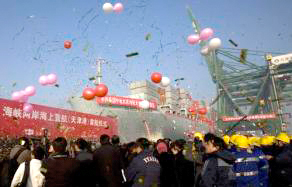
This vessel will be able to freely cross between China and Taiwan, something the governments of both countries hope will boost their economies. Photos provided by Xinhua News Agency.
By Debby Wu
The Associated Press
KEELUNG, Taiwan (AP) — Taiwanese jetliners and cargo ships left Monday, Dec. 15 for China to open a new era of direct air and shipping services with the mainland, formally ending a nearly six-decade ban on regular links between the rivals.
The passenger flights and sailings reflected perhaps the most dramatic improvement in relations between the two sides since they split amid civil war in 1949.
Ties over the years have been consistently tense and occasionally alarming, with both sides amassing missiles that remain pointed at each other across the 100-mile (160-kilometer) wide Taiwan Strait.
Beijing still claims sovereignty over the democratic island and has repeatedly warned that any attempt at a permanent split could trigger a devastating conflict.
Despite the tensions, flourishing economic ties over the past two decades have bound the two sides together, with annual bilateral trade now totaling about $100 billion.
Presiding over the sailing of the first vessel from Taiwan to China since 1949, Taiwanese President Ma Ying-jeou said the new air and maritime links will greatly boost Taiwan’s economy and put an end to the sabre rattling of the past.
“We will use dialogue to replace confrontation and reconciliation to replace conflicts,” said Ma, whose swearing-in seven months ago marked a turning point in cross-strait relations.
Since taking office in May, Ma has moved aggressively to jettison the anti-China, pro-independence policies of predecessor Chen Shui-bian, trying his best to turn the corner on one of the postwar world’s most enduring conflicts.
Besides the shipping and aviation initiatives, he has also sanctioned a significant expansion of Chinese tourist traffic to Taiwan and helped open the way for increased bilateral investment between the sides.
China has reacted warmly and both have agreed to set aside thorny political disputes to focus on trade. The two sides signed a pact early last month to open up the direct links.
Monday’s big events began at 8 a.m. when a Taiwanese Trans Asia Airways jetliner took off from Taipei’s Sungshan airport, transporting 148 Taiwanese tourists and businesspeople on the 80-minute flight to China’s financial capital of Shanghai.
At the same time a China Eastern Airlines plane in Shanghai departed for Taipei, winging its way across the Taiwan Strait.
The flights mean that travelers no longer need to switch planes at a third point — typically Hong Kong — while direct shipping precludes the need for vessels to make a brief stop at the Japanese island of Ishigaki.
The new transportation links mark a major step forward in business ties between Taiwan and the mainland, begun amid great fanfare in the early 1990s, but long limited by political tensions. Before Ma took office in May, direct flights across the strait were limited to Chinese holidays, and ships had to stop briefly at the Japanese island of Ishigaki.
Taiwanese businesses had pushed for years to end the ban on direct links. The new arrangements will save costs and generate new business as both Taiwan and China feel the pinch of the global economic slowdown, said Chiang Pin-kung, head of Taiwan’s semiofficial Straits Exchange Foundation.
“This will contribute greatly to our economic development,” said Chiang, who signed the air and shipping pacts with his Chinese counterpart, Chen Yunlin.
Taiwan’s government said the links will save shippers $36 million a year, while annual savings for air travelers should amount to $90 million.
Still, some Taiwanese remain skeptical of the economic impact of the new links, pointing to the lower than expected number of Chinese tourists visiting the island, and the tough conditions for Taiwan-based mainland investors in the midst of the worldwide economic slowdown.
In Beijing, Xu Lirong, executive vice president of the China Ocean Shipping Group Company, said the direct shipping links will cut the cost of the company’s related freight business by 30 percent. ♦




